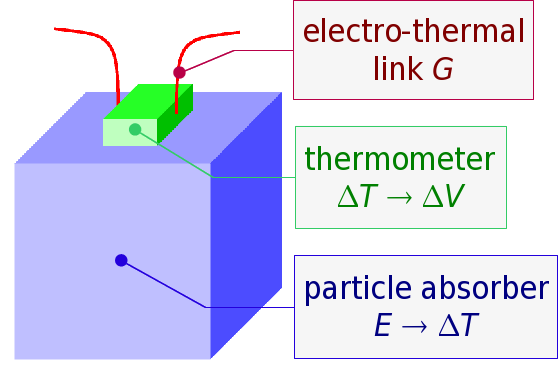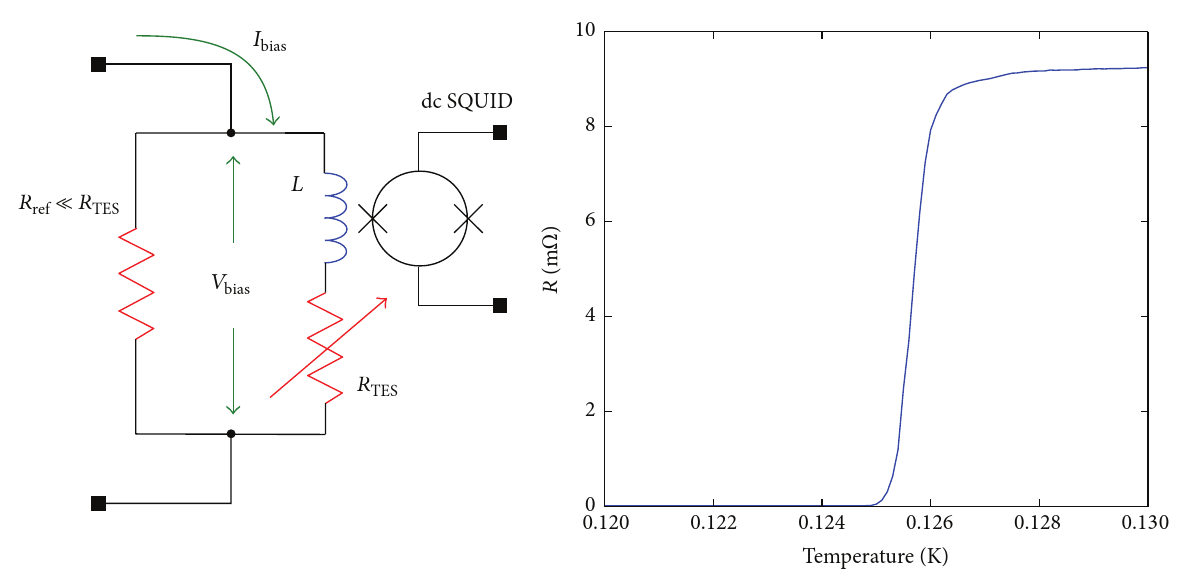Low Temperature Detectors
Low temperature detectors are a class of detectors that leverage material properties at low temperature (normal- and super-conductivity, magnetization, ...) to detect radiation and measure its energy.
Low temperature detectors can be broadly divided in two categories:
- equilibrium detectors which wait for all the deposited energy to have thermalized and measure temperature variations, i.e. changes in the thermodinamic equilibrium phonon energy distribution
- non-equilibrium detectors which do not wait for energy thermalization and are sensitive for example to athermal phonons created in the absorber or to changes in the density of quasi-particles in superconductors
Equilibrium detectors
Working principles
A thermal detector in principle is a very sensitive calorimeter which measures the energy deposited by a single interacting particle through the corresponding temperature rise. For this mechanism to be really effective the detector must have a very small heat capacity: this is accomplished by using suitable materials (dielectrics, superconductors below the phase transition, …) and by running the detector at low temperatures (usualluy below 100 mK) in a refrigerator (we use dilution refrigerators). A thermal detector is made up by three main components:
 |
-
The particle absorber is the sensitive mass of the device. Here the particles deposit their energy. The material can be choosen quite freely but it must have a low heat capacity and it must stand the cooling in vacuum. The absorber can contain any interesting unstable isotope so that it is possible to perfom many interesting experiments like neutrinoless double beta decay searches, dark matter (WIMP) searches or beta decay spectroscopy to measure the neutrino mass. The absorber mass can range from few micrograms to almost one kilogram.
-
The thermometer in a sense is the most important part of the thermal detector since its purpose is to measure the temperature rise induced by the particle interaction. Among the many type of thermometers which have been developed for the thermal detectors we are using doped semiconductor thermistors because their ease of use and the reproducibility with which they can be produced in large quantity.
-
The thermal link to the heat sink which usually provide also the electrical link.
Temperature sensor
Silicon implanted thermistors
...
Neutron Transmutation Doped Germanium thermistor
...
Superconducting Transition Edge Sensors (TESs)
TESs are resistive devices made out of thin films of superconducting materials whose resistivity changes sharply from 0 to a finite value in a very narrow temperature interval around the critical temperature Tc. The superconducting material can be an elemental superconductor (such as tungsten or iridium), although it is more often a bilayer made of a normal metal and a superconductor. With bilayers, Tc of the superconductors is reduced by the proximity effect and can be controlled by adjusting the relative thicknesses of the two layers. Common material combinations used to fabricate TES bilayer with Tc between 0.05 and 0.1 K are Mo/Au, Mo/Cu, Ti/Au, or Ir/Au. TES fabrication exploits standard thin film deposition techniques, photolithographic patterning, and micromachining.
TESs are read-out at a constant voltage and their low impedance is ideal to use SQUIDs to amplify the current signal induced by a particle interaction.
TES microcalorimeter arrays are being actively developed as X-ray spectrometers for many applications, which include material analysis and X-ray astrophysics. TES sensors are particularly well suited to be coupled to metallic (gold) or semimetallic (bismuth) absorbers, providing fast response and energy resolutions lower than few electronvolts.
 |
| Reproduced from A Nucciotti, ADVANCES IN HIGH ENERGY PHYSICS 2016:1–41, 2016. DOI |
Particle absorbers
Dielectric
Metallic
Superconducting
Non-equilibrium detectors
Superconducting microresonators
A very powerful type of non-equilibrium detector is based on a superconducting microresonator in 2003 (P.K.Day et al., Nature 425, p.817 (2003) DOI). These detectors make use of the low loss of superconducting circuits to produce microresonators with very high quality factor, Q, up to several million. The microresonators respond to absorbed radiation by changing their surface impedance, which is reflected as changes in resonant frequency and Q. The surface impedance depends on the density of quasi-particles produced in the microresonator material.
This type of detectors are usually used as bolometers although there are applications to single particle detection.
Each pixel in an array is assigned a unique GHz range resonance frequency. As the detectors are well matched to low-noise cryogenic microwave amplifiers, such as HEMTs, which have multi-GHz bandwidth, multiplexing factors of thousands are theoretically possible. These detectors have the additional advantage that they are comparatively straightforward to manufacture as they do not require micromachining of thermally isolating structures.
 |
| Reproduced from P.K.Day et al., Nature 425, p.817 (2003) DOI) |